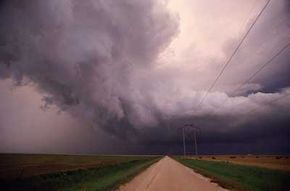Clouds and Precipitation
Clusters of water droplets (called cloud droplets) and crystallized frozen water (called ice crystals or snow crystals) form clouds. A cloud can contain both of these, depending on its temperature. For instance, a cloud's top may be cooler than the lower regions, creating a mix of liquid and frozen water.
Gravity causes all this water to fall as rain. The average size and volume of a cloud droplet is tiny, but, if a cloud droplet manages to attract enough water, the influence of gravity causes it to become a raindrop and fall.
Advertisement
That being said, snow happens a lot like rain. As snow crystals condense and clump together, snowflakes form. When they reach the point where they're too heavy to remain aloft, they fall together as snow. Different surrounding temperatures affect what type of snowflakes will develop. Sometimes on the way down, snowflakes melt into rain; other times they fall intact.

You may be asking, "If water droplets and snow crystals make up clouds, how do we get hail, sleet and freezing rain?" The answer is that once cloud droplets and ice crystals condense and reach critical falling mass, a few additional processes can occur.
- Freezing rain, also known as glaze, can occur where warm and cold air fronts meet. A snowflake can fall into cold air, then pass through a layer of warmer air and melt. As it continues to fall and right before it hits, the snowflake passes through a layer of cold air and becomes supercooled. This means that it won't refreeze, but upon impact with a cold object, such as the street or a tree branch, it will immediately turn to ice.
- Sleet starts the same way as freezing rain, but the melted snowflakes have time to refreeze before they hit the ground.
- Hail forms during severe storms. The gusty updrafts produced by high winds may knock snowflakes and raindrops up and down until the supercooled water droplets collect themselves into chunks of ice. This can happen repeatedly, until the heavy hail can no longer be lifted by the storm's powerful updrafts. The resulting ice chunks can be quite large when they're finally released and create quite an impact if they hit objects like the hood of your car.
Besides precipitation, do clouds serve any other purpose? Clouds have several other important functions that benefit life on Earth. Read about these benefits on the next page.
